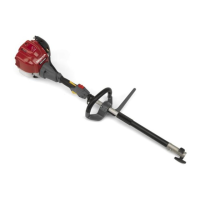20
HELPFUL TIPS & SUGGESTIONS
STORING YOUR POWERHEAD
Storage Preparation
Proper storage preparation is essential for keeping your powerhead
trouble-free and looking good. The following steps will help to keep rust
and corrosion from impairing your powerhead’s function and
appearance, and will make the engine easier to start when you use it
again.
Cleaning
If the engine has been running, allow it to cool for at least half an hour
before cleaning. Clean all exterior surfaces, touch up any damaged paint,
and coat other areas that may rust with a light film of oil.
Using a garden hose or pressure washing equipment can force water into the
air cleaner or muffler opening. Water in the air cleaner will soak the air filter,
and water that passes through the air filter or muffler can enter the cylinder,
causing damage.
Fuel
Depending on the region where you operate your equipment, fuel
formulations may deteriorate and oxidize rapidly. Fuel deterioration and
oxidation can occur in as little as 30 days and may cause damage to the
carburetor and/or fuel system. Please check with your servicing dealer for
local storage recommendations.
Gasoline will oxidize and deteriorate in storage. Deteriorated gasoline
will cause hard starting, and it leaves gum deposits that clog the fuel
system. If the gasoline in your powerhead deteriorates during storage,
you may need to have the carburetor and other fuel system components
serviced or replaced.
The length of time that gasoline can be left in your fuel tank and
carburetor without causing functional problems will vary with such
factors as gasoline blend, your storage temperatures, and whether the
fuel tank is partially or completely filled. The air in a partially filled fuel
tank promotes fuel deterioration. Very warm storage temperatures
accelerate fuel deterioration. Fuel deterioration problems may occur
within a few months, or even less if the gasoline was not fresh when you
filled the fuel tank.
Fuel system damage or engine performance problems resulting from
neglected storage preparation are not covered under the Distributor's
Limited Warranty (U.S.) / Distributor's Warranty (CA.).
You can extend fuel storage life by adding a gasoline stabilizer that is
formulated for that purpose, or you can avoid fuel deterioration
problems by draining the fuel tank and carburetor.
Short Term Storage (30–90 days)
Adding a Gasoline Stabilizer to Extend Fuel Storage Life
When adding a gasoline stabilizer, fill the fuel tank with fresh gasoline. If
only partially filled, air in the tank will promote fuel deterioration during
storage. If you keep a container of gasoline for refueling, be sure that it
contains only fresh gasoline.
1. Add gasoline stabilizer following the manufacturer’s instructions.
2. After adding a gasoline stabilizer, run the engine outdoors for 10
minutes to be sure that treated gasoline has replaced the untreated
gasoline in the carburetor.
3. Stop the engine.
Long Term or Seasonal Storage (greater than 90 days)
Draining the Fuel Tank and Carburetor
1. Make sure the engine oil filler cap is tightened securely.
2. Remove the fuel tank cap and drain the fuel into an approved
gasoline container by tipping the powerhead toward the fuel filler
neck.
3. Press the priming pump several times until all fuel has returned to the
fuel tank.
Gasoline is highly flammable and explosive.
You can be burned or seriously injured when handling fuel.
•
Stop the engine and let it cool before handling fuel.
•
Keep heat, sparks, and flame away.
• Handle fuel only outdoors.
• Keep away from your vehicle.
• Wipe up spills immediately.
ENGINE OIL FILLER CAP
FUEL FILLER NECK
FUEL TANK CAP
FUEL RETURN TUBE
FUEL TANK CAP
PRIMING PUMP
31VP86080.fm 20 ページ 2023年10月5日 木曜日 午後2時22分

